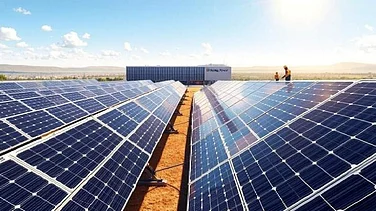Two of India’s neighbouring countries - Sri Lanka and Pakistan have been reeling under unprecedented economic crises for the past few months. Where Sri Lanka’s troubles have increased in view of diminishing forex reserves, huge piles of debt, devaluation of the currency, and rising inflation, it seems Pakistan is also headed towards similar troubles as it looks for a way out amid political instability and burgeoning economic crisis.
As strange as it may sound, Pakistan is relying on donkeys and asking people to drink less tea to sail through the crisis. Besides, petrol and diesel prices have skyrocketed in the country; people are paying as much as PKR (Pakistani rupee) 230 and PKR 260, respectively for a litre of fuel.
Moreover, Pakistan is also reeling under a severe electricity crisis with both urban and rural areas across the country facing extended power outages. This has led to protests against load-shedding with citizens demanding the Pakistan government take immediate steps to ensure a smooth supply of electricity.
This is reminiscent of the similar crisis Sri Lanka is currently facing that has affected millions of people in the country.
Here’s all about the crisis that has engulfed Pakistan:-
Why Is Pakistan Facing An Economic Crisis?
The current situation in Pakistan is mainly due to a large number of policy decisions and the political unrest in the country. Several factors such as external debt, foreign exchange reserves, inflation, etc., are responsible for the deepening economic crisis in Pakistan.
By June 2021, Pakistan’s external debt touched $86.4 billion. The country's total external debt and liabilities increased to $128 billion by March 2022.
The excessive external borrowing added to Pakistan's troubles. The China–Pakistan Economic Corridor (CPEC) created a Chinese debt of $64 billion for Pakistan which was originally valued at $47 billion in 2014.
The decline of the Pakistani Rupee against the US Dollar has further contributed to the ballooning external debt. The low ranking by international rating agencies and grey listing of Pakistan in the Financial Action Task Force (FATF) has kept foreign investors away from the country.
Pakistan fell into the ‘debt trap’ after seeking fresh loans and repaying the old ones. This, coupled with not managing to secure a bailout package from the International Monetary Fund (IMF) has led the country to look for other options.
Inflation in Pakistan touched its highest level in November 2021. This is primarily because of the global rise in crude oil prices leading to costlier freight charges. Importantly, Pakistan is a net importer of essential food items such as pulses, wheat, edible oil, and sugar.
Why People Are Being Asked To Drink Less Tea In Pakistan?
Could drinking less tea save a country from an economic crisis? In Pakistan’s case, it looks like it can.
“I appeal to the nation to cut down the consumption of tea by one-two cups because we import tea on loan.” Federal Minister for Planning Ahsan Iqbal recently said.
He added that Pakistan, one of the biggest importers of tea in the world, has to borrow money to import it.
Tea is quite a popular beverage in Pakistan. The country consumed tea worth $400 million in FY 2021-2022. It imported $60 million worth of more tea than the last fiscal year. The imports of tea worth millions are putting pressure on the already-cash-strapped economy of Pakistan. So, in a way, less tea makes more sense for the people and the country.
What Do Donkeys Have To Do In All This?
It seems donkeys can be of some help to Pakistan in this crisis.
According to the country's economic survey, Pakistan now has the third-largest donkey population in the world. The country’s donkey population grew to 5.7 million in 2021-2022 from 5.5 million a year ago.
Meanwhile, its neighbour China uses donkey hides as a key ingredient in 'ejiao', a traditional medicine. But the population of the animal is declining there. According to a 2019 report in The Guardian, the population of donkeys declined by 76% in the People’s Republic of China since 1992, so it is dependent on imports from other countries.
Sensing an opportunity here, Pakistan has decided to export donkeys to help China meet its demand. Pakistan is also planning to ramp up its export business of donkeys with the Punjab government setting up a farm in Okara district for donkey breeding.
Interestingly, in 2017, the country expanded the global donkey skin trade to aid China. The Khyber-Pakhtunkhwa government had reportedly announced a $1 billion-worth project aimed at increasing the donkey population in the province.
Who All Pakistan Is Seeking Loans From?
In 2018, Pakistan availed of a bailout package from the IMF, but it came with a series of terms that proved costly for the country. IMF loan comes with the condition to reduce the budget deficit, improve banking and tax legislation, strengthen the social safety net for poor households, phase out electricity subsidies, and reduce foreign exchange market intervention by the federal bank. Pakistan could hardly meet the IMF's conditions.
However, this is not the first time the economically beleaguered country was seeking external help. Earlier also in 2013, 2016, and 2018, Pakistan sought external financial aid from the IMF, UAE, and China to fight its economic crisis.
It was reported that in the same year the country had received $1 billion each from Saudi Arabia and the UAE, as part of the bailout packages.
The same year, the then Prime Minister Imran Khan looked to China for a loan but it did not materialise. China refused to extend any fresh loans to Pakistan.
In 2021, it sought another bailout package but the country failed to negotiate with the IMF.
Left with no option, Pakistan approached Saudi Arabia and China for help. Although the conditions with its loans from Saudi Arabia are comparatively more flexible than that from the IMF, the rate of interest, however, is much higher.
The UAE government has also offered to acquire 10 to 12 per cent shares in government-owned companies in Pakistan through its sovereign wealth funds.
Currently, Pakistan is seeking a $2 billion bailout from the IMF but has not received any confirmation due to the latter's “tough prior conditions”.
The free-falling of the Pakistani Rupee
Pakistani Rupee (PKR) is on a ‘free fall’ as it crossed 212 per US Dollar on June 21. Whereas, Pakistan's foreign exchange reserves have depleted to a critical level and the country has less than six weeks of import cover remaining.
The depreciation in PKR’s value comes as Pakistan battles a widening current account deficit, coupled with the State Bank of Pakistan (SBP)-held reserves hitting their lowest level since November 2019. The country has been struggling with a mounting trade deficit driven by its ever-increasing import bills and falling exports. A widening trade deficit and falling investment have led to a sharp fall in the foreign exchange reserves of Pakistan.
What options is Pakistan left with?
Pakistan has no choice but to accept the tough IMF conditions in order to restore the financial agency's programme to avert an economic default. The country needs to implement economic reforms in order to restore its credibility in the markets, along with the continuation of CPEC financing.
Reforms to reduce high trade and current account deficits would require major cutbacks in expenditures and imports. Economists are of the view that curbing unviable development projects, reducing import bills, and relying more on its domestic firms would possibly help Pakistan avoid the deepening crisis further.
However, some are of the view that the resumption of the IMF programme and emergency loans from friendly countries will not provide long-term relief to Pakistan.
Why and how much Petrol and Diesel prices have been increased in Pakistan?
On Thursday, petrol prices in Pakistan were raised to PKR 233 per litre and high-speed diesel prices have gone up to PKR 263 per litre. This is the third time in the past month that fuel prices have been increased but the government did so to fulfil the IMF ‘conditionalities’ to revive the bailout package.
Pakistan’s Finance Minister Miftah Ismail said the government had no choice but to “pass on the impact of international prices” to consumers. This comes after the IMF refused to revive the $6 billion programme if the country fails to remove the fiscally unsustainable fuel and electricity subsidies.
Is Pakistan Facing Similar Crisis as Sri Lanka?
The situation in Pakistan is similar to what we saw in Sri Lanka recently. The country’s crisis could worsen with the shortage of foreign exchange reserves, food, fuel and medicines. Given the economy’s dependence on imports - for both food and fuel, the rising global prices have resulted in a humungous increase in the imports bill of the country.
Pakistan's currency has nosedived just like the Sri Lankan rupee declined in March 2022.
Sri Lanka’s government caused gross failures of the economic policies as the policymakers failed to develop a sustainable strategy for developing industrial infrastructure. The corruption and lack of political will resulted in a huge crisis.
Pakistan does not have any option but to agree to the IMF conditions and remove all consumer subsidies from the energy and power sectors in order to tide over its economic crisis. It has already increased the fuel prices and is moving towards removing the remaining subsidies as well.
The country can also develop its industrial base to pursue a sustainable export economy in order to avoid the balance of payments and the foreign reserves crisis' reoccurrence.































